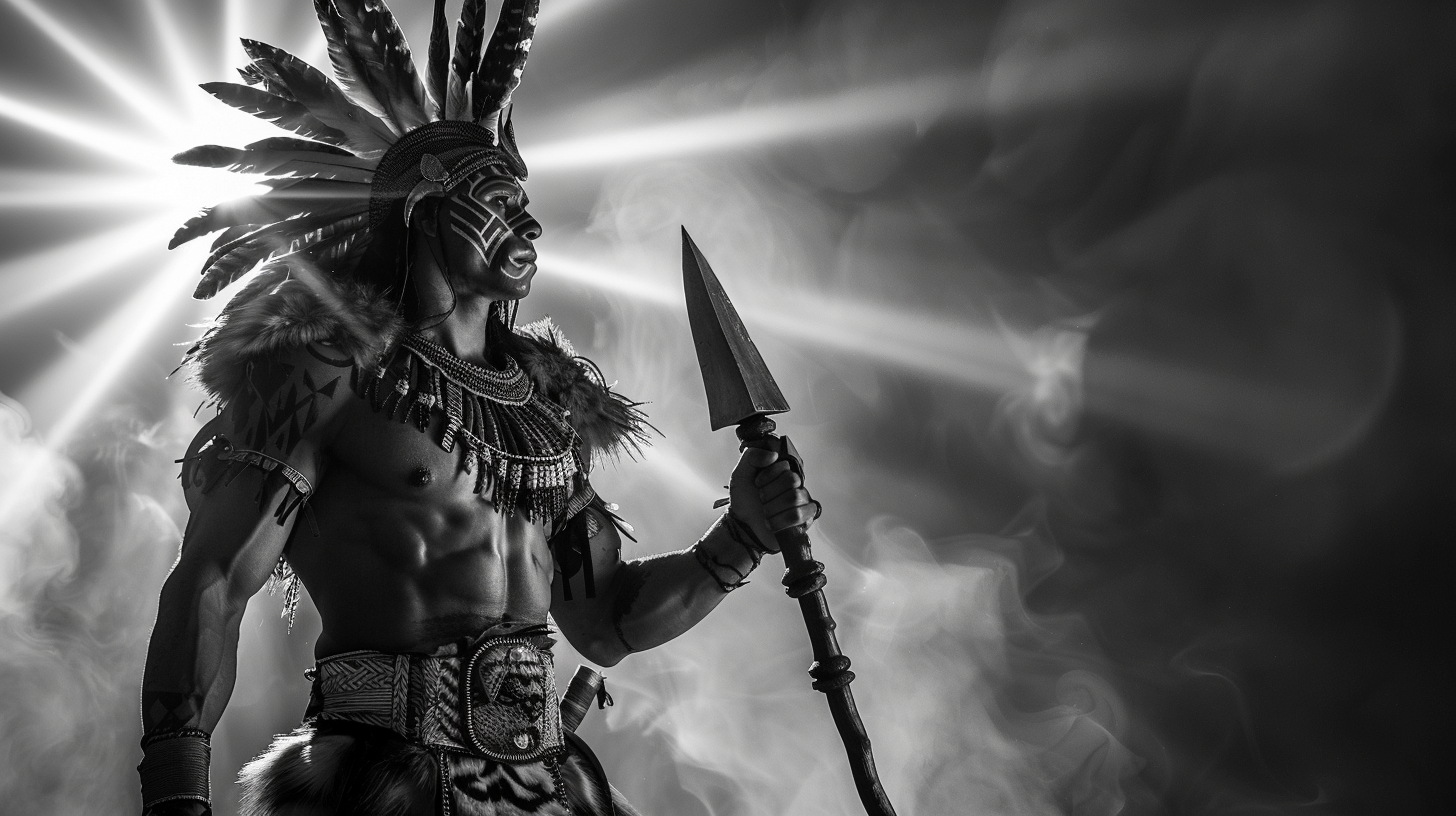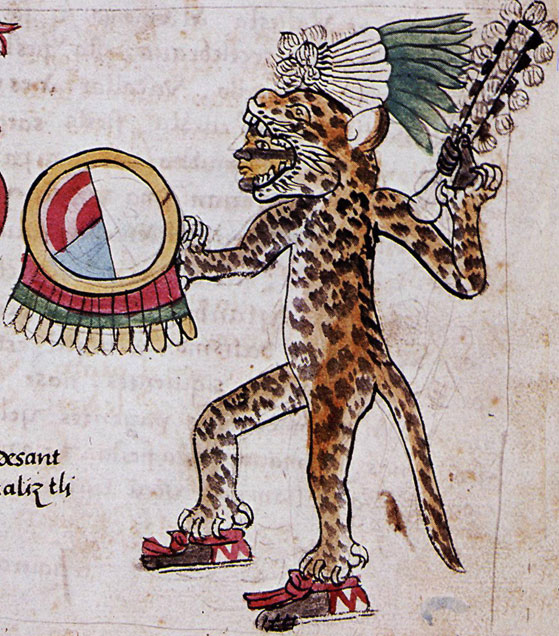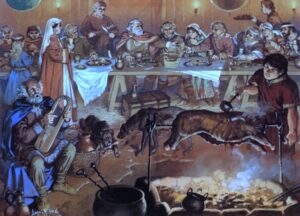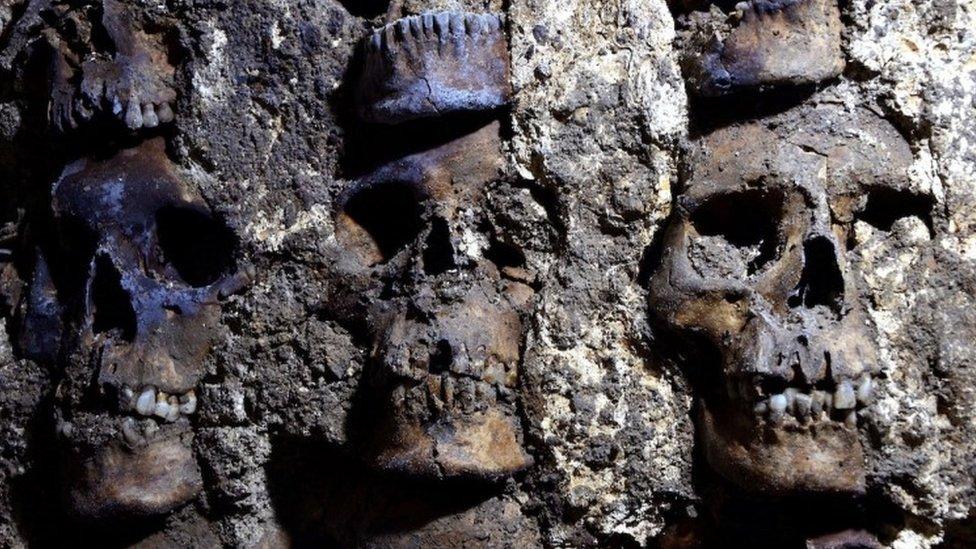
By Julianna Ainsleigh | With archaeological expertise from Barry Gray
His gaze rests on you with the lifeless quality of a shark’s eye. Not hostile. Not cruel. Just assessing
The Aztec warrior played a key role in Aztec society. Viewed with honour and desired, most people are unaware that Aztec warriors had one key aim – capturing live enemies for human sacrifice. But there was not just one type of warrior.
Cuachic: The Shorn One – The Most Feared Aztec Warrior
He stands against the backdrop of Tenochtitlan’s rising pyramids, smoke from the temple fires curling into the sky behind him, but your eyes can’t leave his face. It’s fascinating and terrifying all at once.
He is the ultimate warrior. The one everyone else strives to be.
His head is shaved except for a single long lock at the crown, bound with jade and bone that clicks softly as he shifts his weight.
His skin is painted in stripes of black and ochre, not decoration but markings: each line a kill, each symbol a captive taken. This is his power.

His Stinking Jaguar Pelt Watches You Watching Him
The jaguar pelt draped over his shoulders still has its skull attached, the empty eye sockets seeming to watch you alongside his own flat, unreadable stare.
The smell hits you before you’re ready for it. The pelt isn’t tanned leather but raw hide, reeking of musk and rot and old blood that’s baked into the fur under the sun. Beneath that, copal incense clings to him, mixed with his own sweat and something else. Copper. Fresh copper. The lake breeze can’t touch it.
His arms are scarred in deliberate patterns, ritual cuts that never healed quite right, and his chest bears the stretched marks of bloodletting ceremonies, the kind where you pierce your own flesh with maguey thorns and pull rope through the wound. In his right hand, he holds a macuahuitl, the obsidian-edged club-sword that can decapitate a horse.
Suddenly, You Know What Prey Feels Like
Your body knows something your mind hasn’t caught up to yet, that prey-animal instinct that freezes rabbits in the shadow of hawks. He makes no sound. Not even his breathing.
But it’s his face that stops your breath. His expression is perfectly still, the stillness of something that has stopped being entirely human.
His gaze rests on you with the lifeless quality of a shark’s eye. Not hostile. Not cruel. Just assessing. As if the part of him that recognised other humans as human was cut out during some ritual you’ll never know the name of.
He is a man who has already died, still walking.
How does a human being become this?
In Tenochtitlan, every boy was pointed towards this path from the moment he drew breath. Not some boys. Not the violent ones, the disturbed ones, the ones born wrong. Every boy. Because in the Aztec world, this walking nightmare wasn’t an aberration. He was the goal.
From childhood, boys were hardened deliberately.
Woken in the cold hours before dawn and sent to bathe in icy lake water. Fed just enough to stay sharp and hungry. Taught that comfort was weakness, that mercy was failure, that their worth as human beings would be measured in one currency alone: captives taken alive on the battlefield. Would they make the highest rank? Or would they fade into obscurity?

Live Captures Or Nothing
Because here’s what made the Aztec warrior system truly terrifying. It wasn’t enough to kill your enemies. You had to capture them breathing, drag them back to Tenochtitlan, and hand them over for sacrifice. Kill a man in battle and you gain nothing. No status. No respect. No escape from the shame of remaining a commoner.
The empire ran on a simple equation: live captives equals worth. Everything else equals nothing.
And there was a ladder. Ranks. A hierarchy of horror that boys climbed one bleeding rung at a time.
The Tlamani: Where Everyone Started
You began as a young man with a trembling hand gripping an obsidian-edged weapon, eager to prove yourself. The tlamani were common warriors, and if you returned empty-handed from battle too often, you risked becoming a macehualtin.
As a commoner, your status would define you. Neighbours would notice, and potential wives would turn away, leaving you to spend your life hauling stones for others’ glory.
To change your fate, you’d need to capture someone alone. This is more difficult than killing, as the captive will fight fiercely, knowing their fate. Many have died trying, and many more return with scars and shame.
But if you succeed and bring back that first screaming captive, everything would change for you.

Cuauhli: The Eagle Warriors
Four captives. That’s what it took to join their ranks. Four living men, taken in separate battles, bound and delivered for sacrifice. The initiation was brutal: days of fasting. These hallucinogenic ceremonies made you see your own death. In these bloodletting rituals, you pierced your tongue and fingers with bone needles and pulled rope through the wounds until you transcended pain entirely.
They donned eagle feather costumes and beaked helmets that made them look inhuman. As shock troops, these Aztec warriors were the first to breach enemy lines, wielding wooden shields coloured with symbols of their captives. Their presence alone struck terror into their enemies.
Ocelotl: The Jaguar Aztec Warriors
The Jaguars were a darker counterpart to the Eagles. Unlike the Eagles, who fought in daylight, the Jaguars thrived in the dark, during the nighttime hours. They wore jaguar pelts, sometimes complete with the head, so the warrior’s face emerged from the jaws.
Both groups were required to capture 4 enemies and to endure brutal initiations. However, while Eagles confronted their foes openly, Jaguars operated as ambush predators, using painted skin and silence to strike from the shadows. Their expertise lay in psychological warfare, leaving enemies confused and terrified in the dark.
Cuachic: The Shorn Ones
Then there were the elite warriors who had transcended the ordinary. After proving themselves in battle and capturing many foes, they took a final vow: never retreat, never surrender, and fight until death.
With heads shaved except for a long lock over the left ear—a handle and challenge to enemies—they walked through battles with the calm of those who had already given everything. They were the shark-eyed figures before the pyramids of Tenochtitlan, embodying the nightmare every boy was taught to become.
THIS WAS THE LADDER. This was the system. This was how you turned children into monsters, by making monstrosity the only path to being human.

Deep Dive: Historical Context
The Aztec Empire (c. 1325–1521 CE) maintained one of Mesoamerica’s most sophisticated and brutal military systems ever.
Unlike European feudal armies composed primarily of nobility, the Aztec military structure was theoretically meritocratic: all commoner males were required to undergo military training from childhood, with advancement determined solely by battlefield success. They experienced no childhood as we know it.
This system was intrinsically linked to the empire’s religious cosmology, which demanded a constant supply of sacrificial victims to sustain the sun god Huitzilopochtli and prevent cosmic collapse.
The warrior societies described here — the Cuauhli (Eagle Warriors), Ocelotl (Jaguar Warriors), and elite Cuachic (Shorn Ones) — were documented by Spanish conquistadors and indigenous codices alike, with their initiation rituals and ranking systems forming he pathway to glory.
Archaeological evidence, including temple sculptures depicting warriors, their burials, and drawings, confirms the elaborate costumes and weapons described in historical accounts.
This military culture proved remarkably effective, allowing the Aztecs to dominate Central Mexico until the Spanish conquest of 1521.
Help Us Keep History Alive
We love being able to bring these stories to life and show what happened in our past. If you love our work, then consider supporting us on our Ko-Fi page where you will also get insights into our thoughts behind the stories.









